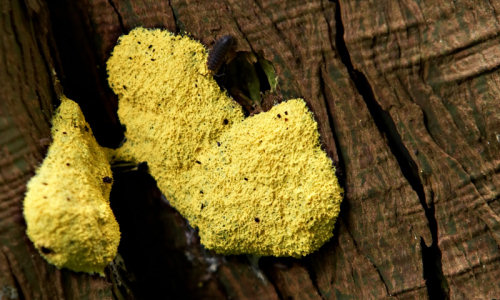A future computer might be a lot slimier than the solid silicon devices we have today. In a study published in the journal Materials Today, European researchers reveal details of logic units built using living slime molds, which might act as the building blocks for computing devices and sensors.
Credits: David C. Lam / Asian Garden
Andrew Adamatzky (University of the West of England, Bristol, UK) and Theresa Schubert (Bauhaus-University Weimar, Germany) have constructed logical circuits that exploit networks of interconnected slime mold tubes to process information.
One is more likely to find the slime mold Physarum polycephalum living somewhere dark and damp rather than in a computer science lab. In its “plasmodium” or vegetative state, the organism spans its environment with a network of tubes that absorb nutrients. The tubes also allow the organism to respond to light and changing environmental conditions that trigger the release of reproductive spores.
In earlier work, the team demonstrated that such a tube network could absorb and transport different colored dyes. They then fed it edible nutrients — oat flakes — to attract tube growth and common salt to repel them, so that they could grow a network with a particular structure. They then demonstrated how this system could mix two dyes to make a third color as an “output.” .
Using the dyes with magnetic nanoparticles and tiny fluorescent beads, allowed them to use the slime mold network as a biological “lab-on-a-chip” device. This represents a new way to build microfluidic devices for processing environmental or medical samples on the very small scale for testing and diagnostics, the work suggests. The extension to a much larger network of slime mold tubes could process nanoparticles and carry out sophisticated Boolean logic operations of the kind used by computer circuitry. The team has so far demonstrated that a slime mold network can carry out XOR or NOR Boolean operations. Chaining together arrays of such logic gates might allow a slime mold computer to carry out binary operations for computation.
“The slime mold based gates are non-electronic, simple and inexpensive, and several gates can be realized simultaneously at the sites where protoplasmic tubes merge,” conclude Adamatzky and Schubert.
Are we entering the age of the biological computer? Stewart Bland, Editor of Materials Today, believes that “although more traditional electronic materials are here to stay, research such as this is helping to push and blur the boundaries of materials science, computer science and biology, and represents an exciting prospect for the future.”
The research was undertaken in a framework of EU FP7 Project “Physarum Chip” (Unconventional Computing program).
Story Source:
The above story is based on materials provided by Elsevier.





